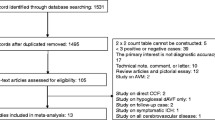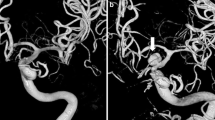Abstract
Background
Magnetic resonance angiography (MRA) is an attractive alternative to conventional catheter angiography (CCA) in children, especially for the detection of intracranial arteriovenous malformations (AVMs) or aneurysms in the out-of-hours setting, because it has fewer risks and complications.
Objective
To compare MRA with CCA for the detection of intracranial AVMs, aneurysms and arterial anatomy in children.
Materials and methods
Retrospective blinded review of MRAs and CCAs by two independent paediatric radiologists, in a group of 19 children already diagnosed with AVMs, aneurysms and subarachnoid haemorrhage (SAH) and who had undergone both imaging techniques.
Results
Abnormalities were identified on MRA in 15 of 19 patients and by CCA in 11 of 19 patients. MRA showed one aneurysm, nine AVMs, three haemorrhages and two indeterminate lesions. CCA showed nine AVMs and two indeterminate lesions. The two modalities showed excellent correlation in the detection of AVMs in nine patients. Vascular supply to the AVMs correlated well in four cases. There was complete disagreement in the determination of vessel supply in one case, and in two cases CCA showed additional vessel supply compared to MRA, while in two further cases MRA showed an additional vessel supply compared to CCA. CCA was superior to MRA in demonstrating arterial anatomy, except with regard to the anterior and posterior communicating arteries where MRA was superior.
Conclusions
The high sensitivity of MRA in the detection of AVMs when compared to CCA and the low incidence of aneurysms support the use of MRA as the initial imaging modality when intracranial haemorrhage is diagnosed on CT, especially in the out-of-hours setting.




Similar content being viewed by others
References
Zimmerman RA, Bogdan AR, Gusnard DA (1992) Pediatric resonance angiography: assessment of stroke. Cardiovasc Intervent Radiol 15:60–64
Glasier CM, Allison JW (1997) Magnetic resonance angiography in children. Clin Neurosci 4:153–157
Vogl TJ, Balzer JO, Stemmler J, et al (1992) MR angiography in children with cerebral neurovascular diseases: findings in 31 cases. AJR 159:817–823
Maas K, Barkovich AJ, Dong L, et al (1994) Selected indications for and applications of magnetic resonance angiography in children. Pediatr Neurosurg 20:113–125
Lee BC, Park TS, Kaufman BA (1995) MR angiography in pediatric neurological disorders. Pediatr Radiol 25:409–419
Davis WL, Boyer RS (1993) Magnetic resonance angiography in pediatric neuroradiology. Top Magn Reson Imaging 5:50–67
Allison JW, Davis PC, Sato Y, et al (1998) Intracranial aneurysms in infants and children. Pediatr Radiol 28: 223–229
Aoki S, Yoshikawa T, Hori M, et al (2000) Two-dimensional thick-slice MR digital subtraction angiography for assessment of cerebrovascular occlusive diseases. Eur Radiol 10:1858–1864
Yadav RK, Sood AK, Sharma A, et al (1998) Comparative evaluation of computed tomography and cerebral angiography in the management of subarachnoid haemorrhage. J Ind Med Assoc 96:241–244
White PM, Teasedale EM, Wardlaw JM, et al (2001) Intracranial aneurysms: CT angiography and MR angiography for detection – prospective blinded comparison in a large patient cohort. Radiology 219:739–749
Jager HR, Mansmann U, Hausmann O, et al (2000) MRA versus digital subtraction angiography in acute subarachnoid haemorrhage: a blinded multireader study of prospectively recruited patients. Neuroradiology 42:313–326
Husain AM, Smergel E, Legido A, et al (2000) Comparison of MRI and MRA findings in children with a variety of neurologic conditions. Pediatr Neurol 23:307–311
Warren DJ, Hoggard N, Walton L, et al (2001) Cerebral arteriovenous malformations: comparison of novel magnetic resonance angiographic techniques and conventional catheter angiography. Neurosurgery 48:973–983
Johnson MR, Good CD, Penny WD, et al (2001) Playing the odds in clinical decision making: lessons from berry aneurysms undetected by magnetic resonance angiography. BMJ 322:1347–1349
Tsuchiya K, Katase S, Yoshino A, et al (2000) MR digital subtraction angiography of cerebral arteriovenous malformations. AJNR 21:707–711
Alberico RA, Barnes P, Robertson RL, et al (1999) Helical CT angiography: dynamic cerebrovascular imaging in children. AJNR 20:328–334
Rollins N, Dowling M, Booth T, et al (2000) Idiopathic ischaemic cerebral infarction in childhood: depiction of arterial abnormalities by MR angiography and catheter angiography. AJNR 21:549–556
Takano K, Utsunomiya H, Ono H, et al (1999) Dynamic contrast-enhanced subtraction MR angiography in intracranial vascular abnormalities. Eur Radiol 9:1909–1912
Hourihan MD, Gates PC, McAllister VL (1984) Subarachnoid haemorrhage in childhood and adolescence. J Neurosurg 60:1163–1166
Cockroft KM, Thompson RC, Steinberg GK (1998) Aneurysms and arteriovenous malformations. Neurosurg Clin North Am 9:565–576
Author information
Authors and Affiliations
Corresponding author
Rights and permissions
About this article
Cite this article
Fasulakis, S., Andronikou, S. Comparison of MR angiography and conventional angiography in the investigation of intracranial arteriovenous malformations and aneurysms in children. Ped Radiol 33, 378–384 (2003). https://doi.org/10.1007/s00247-003-0904-y
Received:
Accepted:
Published:
Issue Date:
DOI: https://doi.org/10.1007/s00247-003-0904-y




